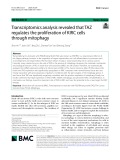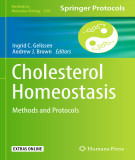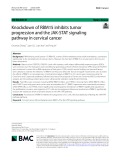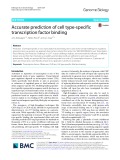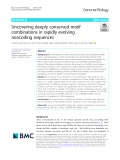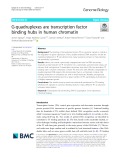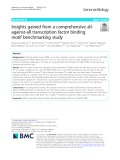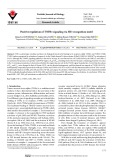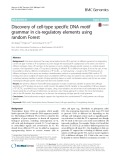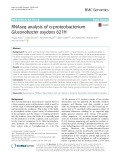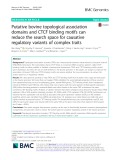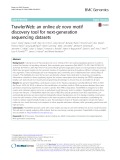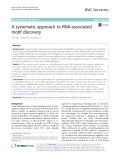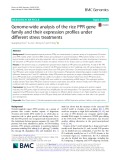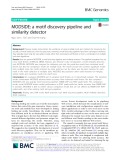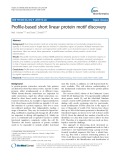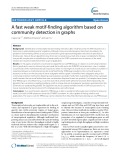
Binding motif
-
Transcriptional Co-Activator with PDZ-Binding Motif (TAZ, also known as WWTR1) is a downstream effector of the Hippo pathway, involved in the regulation of organ regeneration and cell differentiation in processes such as development and regeneration.
 12p
12p  vikoch
vikoch
 27-06-2024
27-06-2024
 1
1
 1
1
 Download
Download
-
Ebook "Cholesterol homeostasis: Methods and protocols" provides state-of-the-art techniques for studying various aspects of cholesterol homeostasis, including its uptake, synthesis and efflux from the cell, as well as its trafficking within the cell. Chapters also cover techniques for studying the regulation of cholesterol homeostasis at both the transcriptional and post-translational levels, as well as studying the membrane topology and structure of cholesterol-related proteins.
 298p
298p  lucchinguyen
lucchinguyen
 28-12-2023
28-12-2023
 7
7
 2
2
 Download
Download
-
RNA binding motif protein 15 (RBM15), a writer of N6-methyladenosine (m6A) methylation, contributes significantly to the development of various tumors. However, the function of RBM15 in cervical cancer (CC) has not been determined.
 13p
13p  vioracle
vioracle
 29-09-2023
29-09-2023
 3
3
 2
2
 Download
Download
-
The human CGGBP1 binds to GC-rich regions and interspersed repeats, maintains homeostasis of stochastic cytosine methylation and determines DNA-binding of CTCF. Interdependence between regulation of cytosine methylation and CTCF occupancy by CGGBP1 remains unknown.
 21p
21p  vihagrid
vihagrid
 30-01-2023
30-01-2023
 7
7
 3
3
 Download
Download
-
Prediction of cell type-specific, in vivo transcription factor binding sites is one of the central challenges in regulatory genomics. Here, we present our approach that earned a shared first rank in the “ENCODE-DREAM in vivo Transcription Factor Binding Site Prediction Challenge” in 2017. In post-challenge analyses, we benchmark the influence of different feature sets and find that chromatin accessibility and binding motifs are sufficient to yield state-of-the-art performance.
 17p
17p  vigalileogalilei
vigalileogalilei
 27-02-2022
27-02-2022
 19
19
 1
1
 Download
Download
-
Understanding the contributions of transcription factor DNA binding sites to transcriptional enhancers is a significant challenge. We developed Quantitative enhancer-FACS-Seq for highly parallel quantification of enhancer activities from a genomically integrated reporter in Drosophila melanogaster embryos. We investigate the contributions of the DNA binding motifs of four poorly characterized TFs to the activities of twelve embryonic mesodermal enhancers.
 24p
24p  viarchimedes
viarchimedes
 26-01-2022
26-01-2022
 10
10
 0
0
 Download
Download
-
Animal genomes contain thousands of long noncoding RNA (lncRNA) genes, a growing subset of which are thought to be functionally important. This functionality is often mediated by short sequence elements scattered throughout the RNA sequence that correspond to binding sites for small RNAs and RNA binding proteins.
 31p
31p  viarchimedes
viarchimedes
 26-01-2022
26-01-2022
 21
21
 0
0
 Download
Download
-
The binding of transcription factors (TF) to genomic targets is critical in the regulation of gene expression. Short, double-stranded DNA sequence motifs are routinely implicated in TF recruitment, but many questions remain on how binding site specificity is governed.
 15p
15p  viarchimedes
viarchimedes
 26-01-2022
26-01-2022
 12
12
 0
0
 Download
Download
-
Positional weight matrix (PWM) is a de facto standard model to describe transcription factor (TF) DNA binding specificities. PWMs inferred from in vivo or in vitro data are stored in many databases and used in a plethora of biological applications. This calls for comprehensive benchmarking of public PWM models with large experimental reference sets.
 18p
18p  viarchimedes
viarchimedes
 26-01-2022
26-01-2022
 9
9
 0
0
 Download
Download
-
TNF is a pleiotropic cytokine and shows its biological function by binding to its receptors called TNFR1 and TNFR2. While TNFR1 induces apoptosis by activation of caspase-8 via the “death domain”, it also activates IKKα/β, MKK3/6, MKK4/7 by activation of TAK1. Although the TNFR1 signaling pathway is known by in large, it is not known how AKT and MAPKs p38, ERK1/2, and JNK1/2 are activated.
 9p
9p  thiencuuchu
thiencuuchu
 27-11-2021
27-11-2021
 5
5
 1
1
 Download
Download
-
It has been observed that many transcription factors (TFs) can bind to different genomic loci depending on the cell type in which a TF is expressed in, even though the individual TF usually binds to the same core motif in different cell types. How a TF can bind to the genome in such a highly cell-type specific manner, is a critical research question. One hypothesis is that a TF requires co-binding of different TFs in different cell types.
 8p
8p  vilarryellison
vilarryellison
 29-10-2021
29-10-2021
 10
10
 0
0
 Download
Download
-
The acetic acid bacterium Gluconobacter oxydans 621H is characterized by its exceptional ability to incompletely oxidize a great variety of carbohydrates in the periplasm. The metabolism of this α-proteobacterium has been characterized to some extent, yet little is known about its transcriptomes and related data. In this study, we applied two different RNAseq approaches. Primary transcriptomes enriched for 5′-ends of transcripts were sequenced to detect transcription start sites, which allow subsequent analysis of promoter motifs, ribosome binding sites, and 5´-UTRs.
 17p
17p  vilarryellison
vilarryellison
 29-10-2021
29-10-2021
 12
12
 1
1
 Download
Download
-
Topological association domains (TADs) are chromosomal domains characterised by frequent internal DNA-DNA interactions. The transcription factor CTCF binds to conserved DNA sequence patterns called CTCF binding motifs to either prohibit or facilitate chromosomal interactions. TADs and CTCF binding motifs control gene expression, but they are not yet well defined in the bovine genome. In this paper, we sought to improve the annotation of bovine TADs and CTCF binding motifs, and assess whether the new annotation can reduce the search space for cis-regulatory variants.
 17p
17p  vibeauty
vibeauty
 23-10-2021
23-10-2021
 21
21
 0
0
 Download
Download
-
A strong focus of the post-genomic era is mining of the non-coding regulatory genome in order to unravel the function of regulatory elements that coordinate gene expression (Nat 489:57–74, 2012; Nat 507:462–70, 2014; Nat 507:455–61, 2014; Nat 518:317–30, 2015).
 9p
9p  vibeauty
vibeauty
 23-10-2021
23-10-2021
 8
8
 1
1
 Download
Download
-
Sequencing-based large screening of RNA-protein and RNA-RNA interactions has enabled the mechanistic study of post-transcriptional RNA processing and sorting, including exosome-mediated RNA secretion. The downstream analysis of RNA binding sites has encouraged the investigation of novel sequence motifs, which resulted in exceptional new challenges for identifying motifs from very short sequences (e.g., small non-coding RNAs or truncated messenger RNAs), where conventional methods tend to be ineffective.
 17p
17p  vibeauty
vibeauty
 23-10-2021
23-10-2021
 10
10
 0
0
 Download
Download
-
Pentatricopeptide-repeat proteins (PPRs) are characterized by tandem arrays of a degenerate 35-aminoacid (PPR motifs), which can bind RNA strands and participate in post-transcription. PPR proteins family is one of the largest families in land plants and play important roles in organelle RNA metabolism and plant development. However, the functions of PPR genes involved in biotic and abiotic stresses of rice (Oryza sativa L.) remain largely unknown.
 14p
14p  vitzuyu2711
vitzuyu2711
 29-09-2021
29-09-2021
 3
3
 1
1
 Download
Download
-
Previous studies demonstrate the usefulness of using multiple tools and methods for improving the accuracy of motif detection. Over the past years, numerous motif discovery pipelines have been developed. However, they typically report only the top ranked results either from individual motif finders or from a combination of multiple tools and algorithms.
 9p
9p  vitzuyu2711
vitzuyu2711
 29-09-2021
29-09-2021
 7
7
 1
1
 Download
Download
-
Short linear protein motifs are attracting increasing attention as functionally independent sites, typically 3–10 amino acids in length that are enriched in disordered regions of proteins. Multiple methods have recently been proposed to discover over-represented motifs within a set of proteins based on simple regular expressions.
 9p
9p  viwyoming2711
viwyoming2711
 16-12-2020
16-12-2020
 9
9
 0
0
 Download
Download
-
Identification of transcription factor binding sites (also called ‘motif discovery’) in DNA sequences is a basic step in understanding genetic regulation. Although many successful programs have been developed, the problem is far from being solved on account of diversity in gene expression/regulation and the low specificity of binding sites.
 14p
14p  viwyoming2711
viwyoming2711
 16-12-2020
16-12-2020
 18
18
 1
1
 Download
Download
-
The NTF2-like superfamily is a versatile group of protein domains sharing a common fold. The sequences of these domains are very diverse and they share no common sequence motif. These domains serve a range of different functions within the proteins in which they are found, including both catalytic and non-catalytic versions.
 11p
11p  viwyoming2711
viwyoming2711
 16-12-2020
16-12-2020
 9
9
 1
1
 Download
Download
CHỦ ĐỀ BẠN MUỐN TÌM








